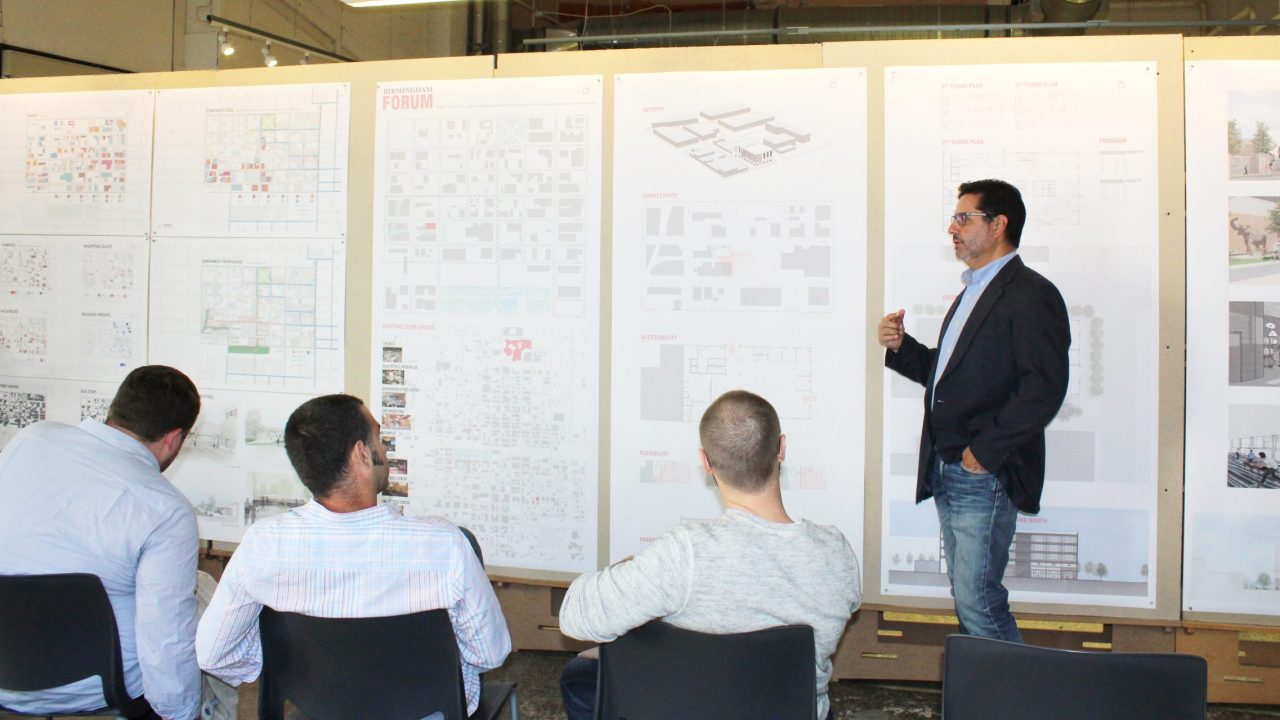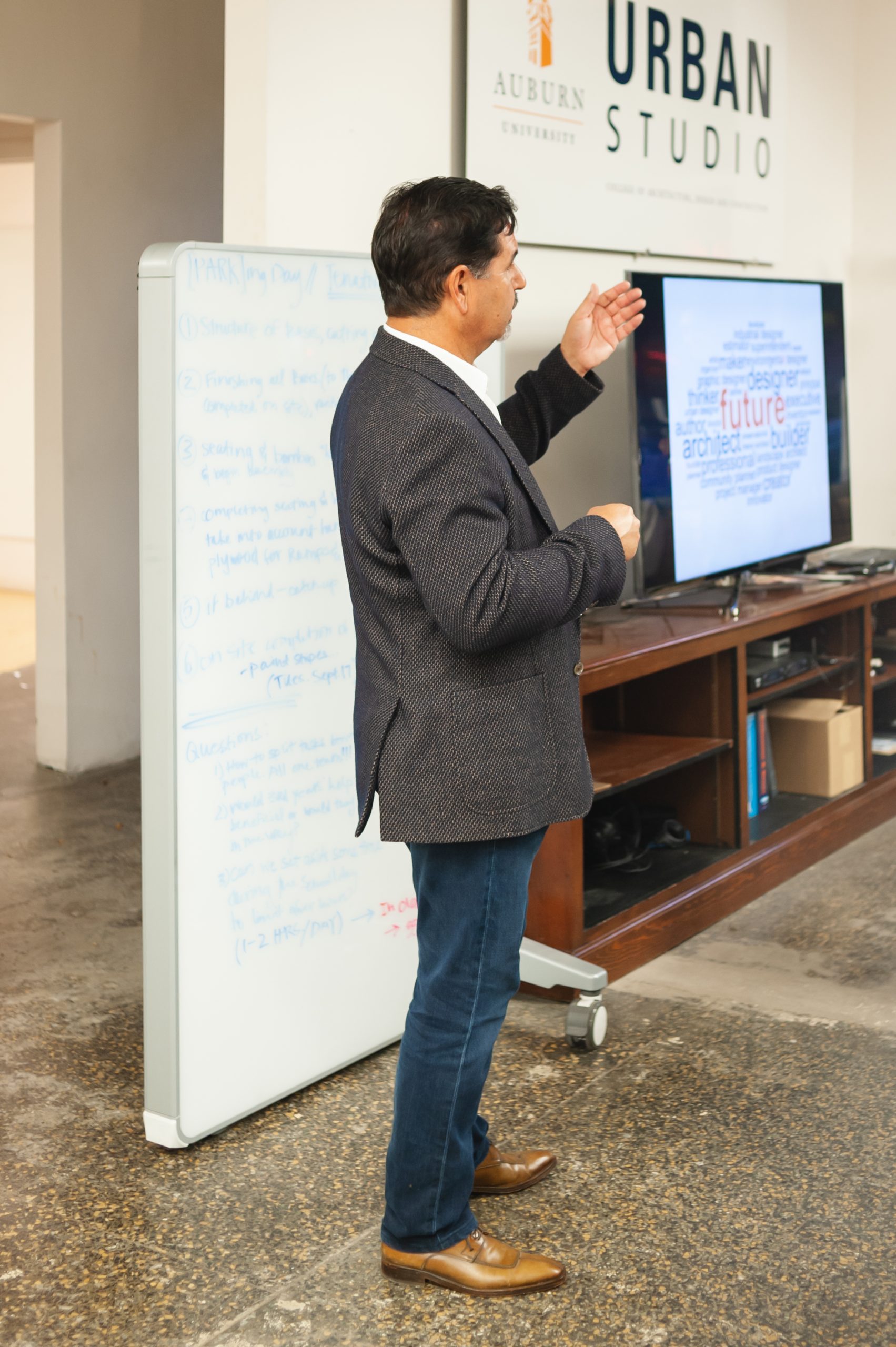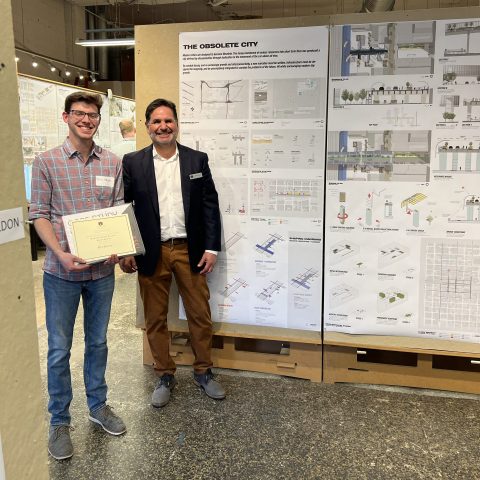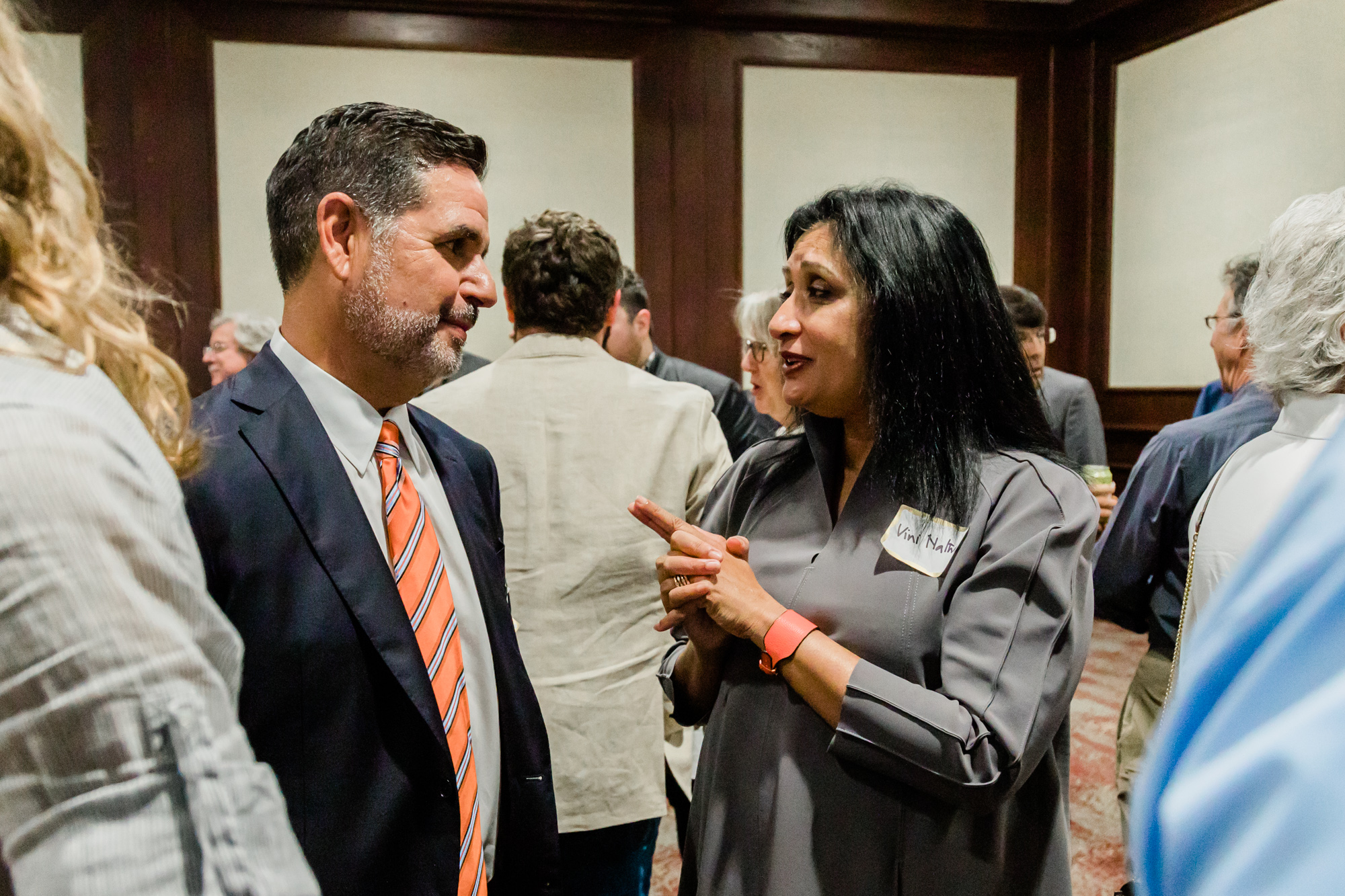Leading the Living Classroom

Urban Studio Director Alex Krumdieck
In Auburn’s College of Architecture, Design and Construction, fifth-year architecture students have the option to spend a year in Birmingham to study and experience what it means to be an architect in an urban setting.
Birmingham is a living classroom for architecture students. It gives them the opportunity to experience how architecture affects life in a city—from housing and commerce to history and politics, urban architecture does not exist in a vacuum.
Under the direction of Alex Krumdieck ‘86, the Urban Studio continues to embrace its dual roles of educator and citizen as the program works with urban areas throughout the state as well as within the City of Birmingham.
In addition to his role as Urban Studio’s director, Krumdieck is an award-winning architect who has lived and practiced in Birmingham for over 30 years. This year marks his tenth at the helm of the Urban Studio—a milestone also marked by the opening of the university’s educational hub in Birmingham.

From Pre-Med to Urban Studio
Krumdieck is the third director in the Studio’s 33-year history. However, there was a point when architecture was not a part of his plan. The son of doctors, he was looking more towards joining the “family business” despite growing up enjoying his time woodworking in his father’s workshop as well as building model airplanes with his uncle.
As a student at Birmingham’s John Carroll Catholic High School, Krumdieck attended a career day that featured an architect. Although this piqued his interest, he remained on his pre-med path and enrolled at Auburn. As an undergrad, he befriended two architecture students, often indulging his passion for building by assisting with their models. Soon thereafter, Krumdieck took the leap and switched from pre-med to architecture.
Eventually, Krumdieck founded his own architecture studio, Krumdieck Architecture + Interiors (KAI) in 1993. The firm has enjoyed continued success with award-winning projects throughout the southeast.
At one point, he re-kindled his interest in teaching (his father was also a professor of medicine at UAB) and returned to school for a graduate degree that would allow him the option to teach. The success of KAI pre-empted his career in education.
Twenty years later, he was approached by then-director Cheryl Morgan, FAIA, to teach seminars at the Urban Studio. Krumdieck joined a group of other Birmingham-based architects—Bill Segrest, Chris Giattina, Chris Ingle and Brian Barrett—to teach the studio, work directly with the students and serve as their thesis jurors.
“It was fun and we had a good time doing it. It was also a way for us to connect outside of our offices,” Krumdieck recalls.
When Morgan began making plans to retire, she approached Krumdieck to see if he was interested in taking over the leadership role at Urban Studio. When she retired, Krumdieck became interim director, eventually landing the role permanently.
[Urban Studio students] become invested in creating a solution and answering a neighborhood’s needs in creative ways that benefit the whole community. We get to see our students’ perspectives expand beyond a building.
The City as a Living Classroom
As a working architect, Krumdieck is able to bring aspects of the ever-changing profession to Urban Studio students in a way that builds on their classroom-based theory education while providing real-world experiences through projects and internships. During their year in Birmingham, students are exposed to a lot of information in a relatively short period of time.
A setting like Birmingham gives Krumdieck the opportunity to demonstrate how architecture is more than an aesthetic solution. Student discussions often include how a building can impact a whole area, often changing that area in both expected and unexpected ways. Urban Studio students look at how their proposed solutions affect not only the individual building but also the block it is located on and the district it is in.
Krumdieck cited Railroad Park as an example of how a multi-million-dollar development project connecting citizens, organizations, businesses and government generated hundreds of millions of dollars in additional investment in the city. Parks, buildings, development plans—the architect is usually one of the smaller parts of projects like this, but the ultimate impact is greater than the sum of its parts.

This often leads to additional discussions on the impact of architecture, especially through the students’ thesis projects, which is one factor that sets the Urban Studio apart from other programs. Students are immersed in the community. They have to figure out what people need by talking with them, visiting sites and understanding how their potential solutions will affect not just the building site but the people who live around it.
“In my role at the Urban Studio, I have the privilege of seeing our students go out and meet people in the neighborhoods and watch as they become empowered by the very simple things people are asking for and how it’s not just about creating a beautiful object.” Krumdieck added. “They become invested in creating a solution and answering a neighborhood’s needs in creative ways that benefit the whole community. We get to see our students’ perspectives expand beyond a building.”
Working with Students
One of the benefits for students working at Urban Studio is the exposure to local architects, firms and projects. Krumdieck brings decades of experience to the Urban Studio, and he leverages his relationships to enhance the student experience. This gives students access to people who may be their future colleagues or employers as well as different perspectives on the profession, something not always available in a classroom.
When you ask local architects about their experiences with Krumdieck and the Urban Studio, there’s no doubt Krumdieck is in his element. His gracious and collaborative nature brings the community together to support the next generation of architects and he sets that tone at the Studio.
Ben Wieseman ’12 summed up the student experience with: “He brings this wealth of information into the Studio and to the students through the types of projects, his relationships in the community and with local professionals and the other Auburn programs he exposes them to. One of his strengths is also the atmosphere he sets in the Studio, which provides the students with structure in their day while also giving them creativity, freedom and fun to explore ideas and challenge themselves.”
It’s more than the atmosphere within the Studio. Krumdieck also works with local firms to place students in internships that challenge and support them as they learn what it takes to work in an architecture firm. He brings interns into KAI as well. Jack McMullen ’24 interned at KAI during his fifth year at the Studio.
“It was very easy to transition from Urban Studio to interning at KAI,” McMullen explained. He appreciated how the collaborative and educational environments at both the Studio and the firm made it easier for him to come in and be confident about making decisions.
His internship at KAI was also beneficial for his future, “Because the firm is small and we are all in one office, I was able to listen to many conversations about the overall direction of the firm—conversations that would normally happen between the principals behind closed doors. This has given me a better understanding of the inner workings of an architecture firm and a broader perspective of everything that goes into a successful project.”

Krumdieck’s support for his students’ futures continues beyond the classroom, and even beyond graduation. In April 2024, he accompanied students when they presented to the International Making Cities Livable conference in Rhode Island. Impressed by their presentation, one of the audience comments noted, “the approach they’re taking bodes well for both their futures and that of the program.”
Students often stay in touch with Krumdieck long after graduation. He recalled one of his former students in particular who has remained in contact over the years as their relationship evolved from student-mentor to friendship. They continue to talk about his career as it has taken him to different cities as well as enjoying a few rounds of golf here and there. These relationships mean a lot to Krumdieck, who appreciates how the atmosphere at Urban Studio sets the stage for building these kinds of relationships as well as the relationships between students.
Thoughts on the Future
The Urban Studio program continues to evolve as the profession does. One important thing for future architects to consider is context. Understanding the context of a project is collaborative in nature, something that can be a challenge both in the academic and professional realms. Understanding the importance of context and collaboration is vital for future architects.


Krumdieck envisions an increasingly collaborative environment for the future of the Urban Studio. From the understanding that buildings live in context with both obvious and underlying forces to getting away from simply creating a beautiful object, students will need a broader vision to take into their future careers.
“Right now, we only scratch the surface of the contextual aspects of architecture. There are impacts from ordinances, historic neighborhoods and the continually changing physical environment, to name a few. As architects, we need to understand how all of these things come together and how we contribute to the communities we work in,” Krumdieck explained. “Once you’re a practicing architect, you start to see how a building can make someone happy or even make them miserable. To this end, we need to think of the why in addition to the where, the when and the how. I hope this new building will help us inspire other Auburn programs to come up and collaborate with architecture students to help equip them with the knowledge to understand how to get to the why.”
Connection. Collaboration. Communication. The Urban Studio is positioned to have an even greater impact on the future. At Auburn the students, the program, and the profession are in good hands with opportunities like Urban Studio.
###
Auburn University’s Center for Architecture and Urban Studies—the Urban Studio—is a teaching and outreach program of Auburn’s College of Architecture, Design, and Construction. Students are immersed in the extraordinarily rich “laboratory” of downtown Birmingham, where their work includes professional seminars and studio design projects that typically focus on community development and urban planning.
Want to learn more about the Urban Studio experience?
See more in:
Alumni, Alumni Recognition, Faculty Recognition, Industry Engagement, Student Experience, Urban Studio
Related people:
Alex Krumdieck, Ben Wieseman, Jennifer Cloe